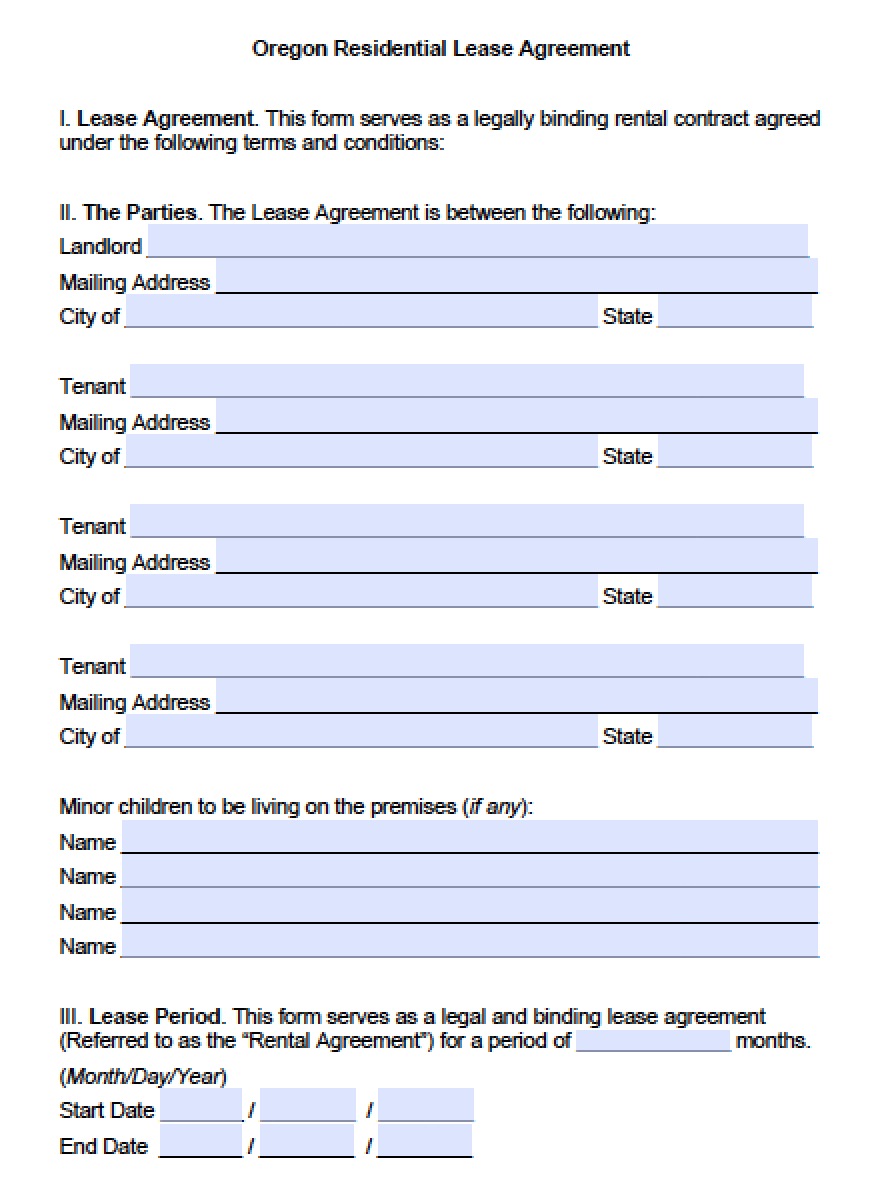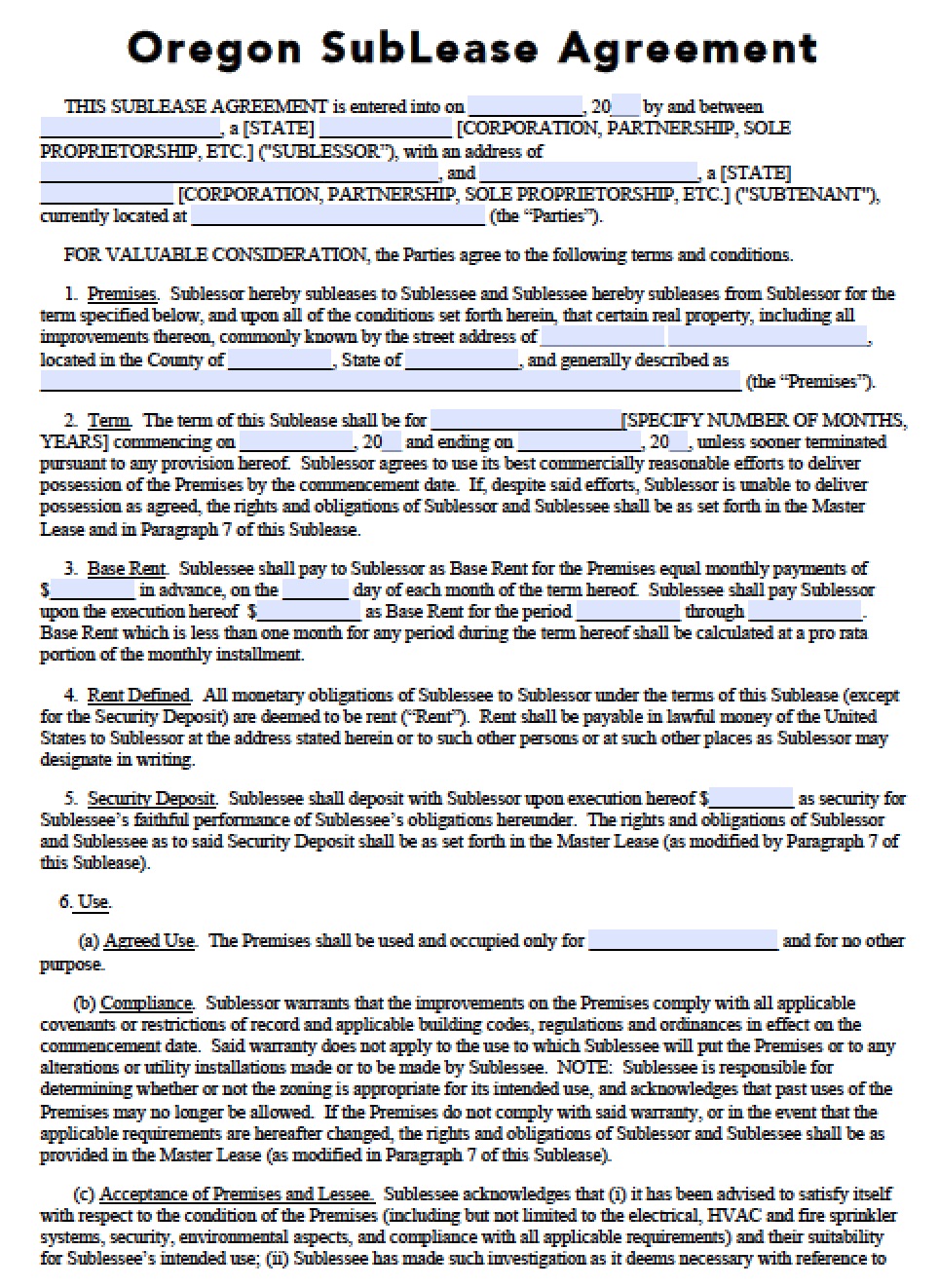
The Oregon rental lease agreements are used for tenants seeking to rent space from the owner of residential or commercial property. The tenant will need to make regular payments to the landlord in exchange for using the leased space (usually made on the first of every month). Before signing a contract, the landlord may ask for the tenant’s personal information to conduct a background check and determine whether they are able to afford the rent payments. Access to the property should only be granted after both parties consent to the rental arrangement and sign the lease. If the landlord requests a security deposit, the transfer should be made prior to the start of the lease term.

The Oregon month-to-month lease agreement is a document used by a lessor and lessee (a.k.a., the landlord and tenant) to define the rental terms for a tenancy with no predetermined end date. In a month-to-month rental agreement, both the landlord and tenant are able to cancel the arrangement by providing the other with at least thirty (30) days’ notice before the subsequent rental period. Both parties should understand that they will be held to the same responsibilities as a long-term…
36,906 DownloadsThe Oregon rental application grants landlords the ability to legally review the personal and confidential information of a potential tenant. The collected data will aid the landlord in evaluating whether the individual is worthy of a rental contract. If the landlord approves of the tenant, the lease may be executed, and the security deposit (if applicable) may be transferred before allowing access to the property. Note that there is no State law regulating how much a landlord may request for…
28,338 Downloads
The Oregon standard residential lease agreement is the most common rental contract, one which lasts one (1) year with rent payments made by the tenant on a monthly basis. Landlords are encouraged to screen tenants with the rental application before signing any type of agreement. The information collected through the application helps the landlord determine whether a long-term lease is suitable for the applicant. As with other rental contracts, a security deposit may be collected before officially authorizing a lease agreement….
19,678 DownloadsThe Oregon three (3) day notice to quit for the nonpayment of rent is used by landlords when a tenant neglects to pay rent on time. The notice informs the tenant that they have three (3) days to either pay the total amount due or vacate the premises. For week-to-week tenancies, the landlord cannot deliver the notice until the fifth (5th) day of the rental period. For month-to-month tenancies and fixed-term leases, the landlord must wait until the eighth (8th)…
15,791 DownloadsAn Oregon commercial lease agreement is a document used for business tenants seeking to occupy an industrial, office, or retail space. The rental term is typically between one (1) and five (5) years with options to renew at the tenant’s decision. Rental increases may either be fixed, adjusted to the Consumer Price Index (CPI – see link), or negotiated in “good faith” at the time of the term end date. All business tenants should have their background reviewed by the…
12,217 Downloads
The Oregon sublease agreement is designed for a tenant looking to rent either their entire space or a bedroom to someone else. Permission to sublet must always be obtained from the landlord if the original lease does not state that subletting is allowed. The original tenant, or “sublessor,” will be held liable for any damage and will remain responsible for making the monthly payment regardless of whether the new tenant, or “sublessee,” decides to pay. The sublessor must follow all…
7,514 DownloadsCarbon Monoxide (§ 90.316) – If any unit in the building emits carbon monoxide, there must be a tester installed, and the tenants must sign this discloser form.
Common Utilities (§ 90.315) – If the tenant is responsible for any utilities that are for common areas or for the landlord, it must be disclosed in the rental contract.
Flood-Map (§ 90.228) – If the residence is located in a flood zone, the tenant must be informed of this information.
Identification (§ 90.305) – The landlord must state the name and address of any manager or person authorized to act in their place. This information must be written in the lease agreement.
Lead-Based Paint – This disclosure states the history of lead paint use in a dwelling. Tenants must review and sign the disclosure if the housing was constructed before 1978.
Legal Notices (§ 90.310) – If the housing unit contains four (4) or fewer units, the following information must be disclosed (if applicable):
Recycling (§ 90.318) – If the housing is located in an urban growth boundary and has more than four (4) units, the tenant must be made aware of the opportunity to recycle.
Smoking Policy (§ 90.220) – If there is a smoking policy on the property, it must be presented to the tenant.
Maximum – There is no State cap on how much a landlord may charge.
Returning (§ 90.300(13)) – The lessor must give back any deposit within thirty-one (31) days after the end of the tenancy.
Notice must be given to the tenant within twenty-four (24) hours of any entry by the lessor (§ 90.322).